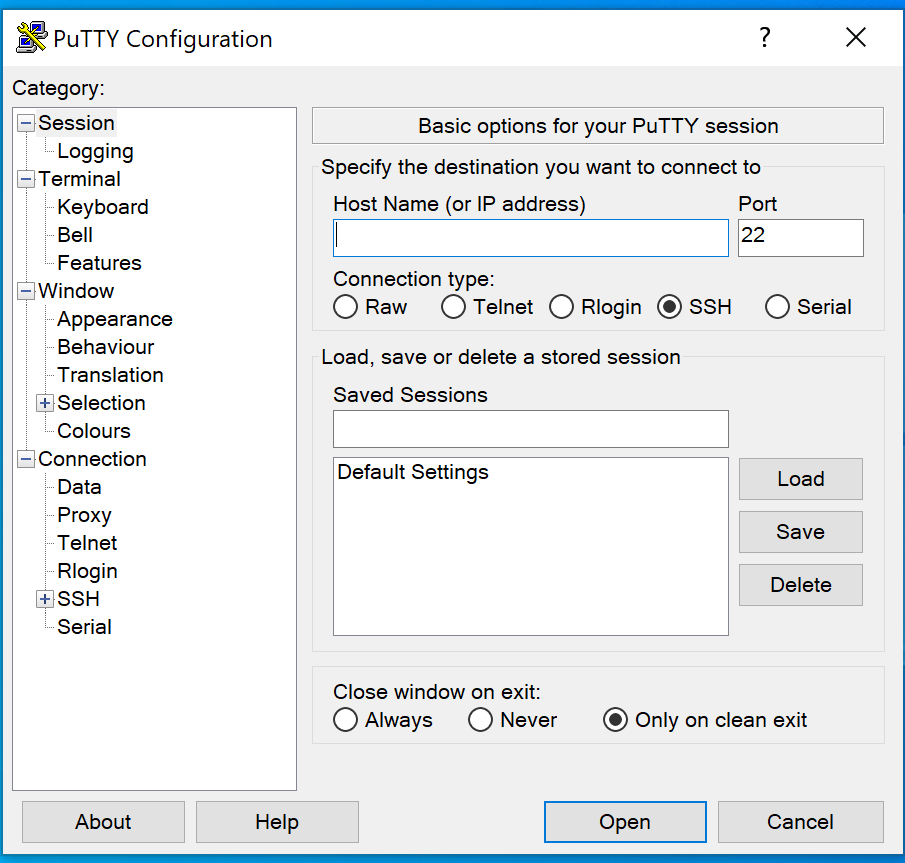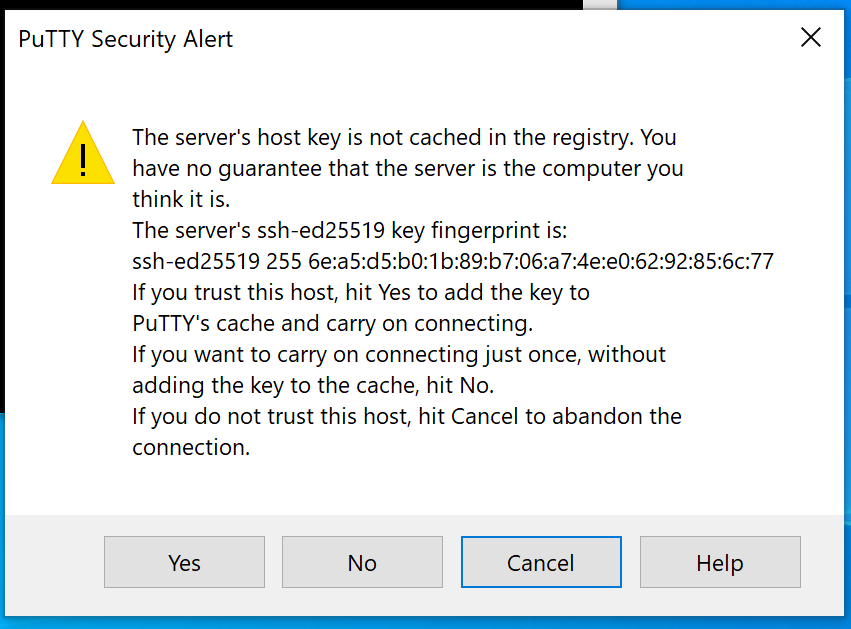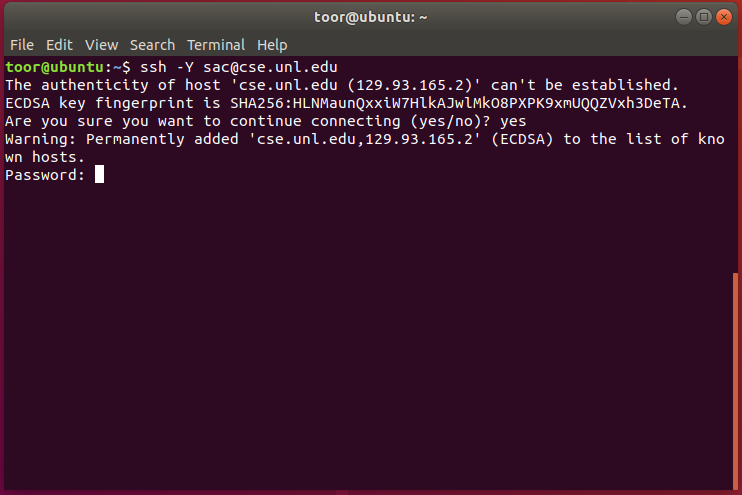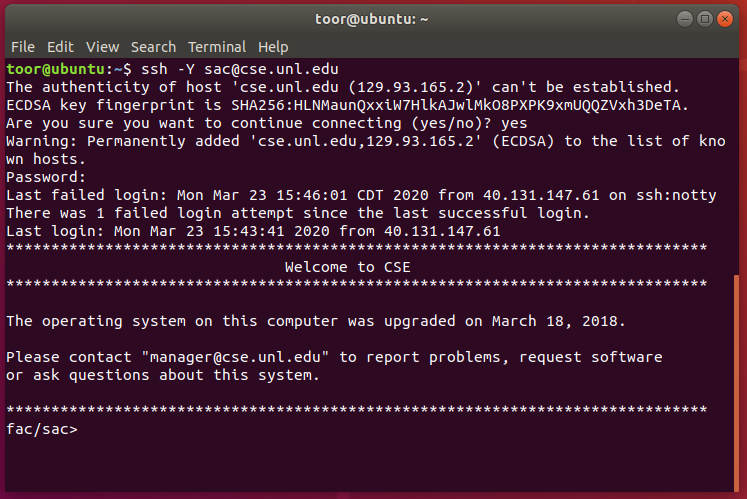School of Computing Resources
Students enrolled in courses (CSCE, SOFT, and RAIK) taught by faculty of the School of Computing, (CSCE, SOFT or RAIK) automatically have accounts on the nuros.unl.edu, (formerly known as cse-linux-01.unl.edu) server. To access this server, the easiest way is to open a terminal window in MacOS, or the Command Prompt or PowerShell in Windows 10 or 11, and use the ssh command:
ssh jdoe2@nuros.unl.edu
Substituting your MyRed login for jdoe2 in the command and entering your MyRed password when prompted. If you have never logged into the nuros.unl.edu server, a new home directory will be created for you. The nuros.unl.edu server offers a variety of software development tools, frameworks and services including MySQL server accounts. You can also access nuros.unl.edu using the NoMachine application if a GUI interface to the server is needed.
Some students may need a School of Computing (SoC) account (refered to as your CSE account) if they are doing research with faculty or accessing legacy software that is only available on the legacy CSE systems. This CSE account is used to access legacy SoC servers, websites, and network shares. A CSE account is separate from a My.UNL account (e.g. jdoe2) which is used to access UNL services like Canvas, Box, and Microsoft 365, and a TrueYou account (e.g. 12345678) which is used to access NU (system-wide) services like MyRED and Firefly. Usernames for CSE accounts do not contain any numbers, and the password for your CSE account is not synchronized to your My.UNL or TrueYou account password. If you have been told by an instructor or faculty member that you need to access the legacy systems using a CSE account, you can create one online at https://cse.unl.edu/claim by entering your full @huskers.unl.edu email address. After submitting your Huskers email address, you’ll receive a confirmation email at that address; click the link in the email to verify your identity and set up your new CSE account. This process will prompt you to choose your own password for your account, complete the consent form to agree to the university’s computer use guidelines, and then provide you with the username (or LoginID) for your CSE account. Make note of the username/LoginID for your CSE account, as it will be different than the My.UNL account username you use to access Canvas and other UNL services.
If you already have a CSE account (e.g. from a previous CSCE/SOFT/RAIK course) but don’t remember your username, go to https://cse.unl.edu/lost_login. If you have forgotten your password, go to https://cse.unl.edu/reset_password. Both links will prompt you to enter your full @huskers.unl.edu email address to have your CSE login sent to you or request your password be reset.
Below is a quick start guide on resources available for students enrolled in SoC courses.
Printing: A printer is available for all SoC students in Avery 15. To print to a printer, then follow the appropriate instructions below:
- Windows: https://computing.unl.edu/faq/winprt
- MacOS: https://computing.unl.edu/faq/macprt
- Linux: https://computing.unl.edu/faq/lnxprt
Printer access is dependent on having the correct settings for your connection to the EDUROAM network on campus.
Storage: While OneDrive can be accessed through a web browser on our lab computers, when developing code on lab computers, we recommend using a thumb drive or mapping a network share. One is made available to School of Computing students (referred to as your home directory) You will first need to claim your CSE account by visiting the link at the top of this document, then follow the instructions below.
Mapping your home directory to lab computers: https://computing.unl.edu/faq/labdrv
Access your CSE home directory from a personal device:
Accessing OneDrive on lab computers: https://computing.unl.edu/faq/onedrive
Handin: If your course requires you to submit code or use the web grader you might be asked to use handin. The handin application: https://cse.unl.edu/handin uses your MyRed login and password to submit assignments.
Remote Linux Access: A lot of classes in the School of Computing will require you to access our remote Linux server using Secure Shell (SSH). The links below show the step-by-step process of using SSH to connect to the servers.
- Windows: https://computing.unl.edu/faq/winssh
- MacOS: https://computing.unl.edu/faq/macssh
- Linux: https://computing.unl.edu/faq/lnxssh
Helpful links and getting additional support:
- CSE Account Management Portal: http://cse.unl.edu/account
- FAQs: https://computing.unl.edu/faq
- Email Support: support@cse.unl.edu
- CSE System Administration: Room 27 Avery Hall, 402-472-7757
Connecting to cse.unl.edu and other Unix servers with SSH from Windows
You can connect to the School of Computing (SoC) CSE server (cse.unl.edu) and other UNIX servers in the department using the PuTTY SSH client.
PuTTY can be downloaded from the this web site. After you have downloaded and installed PuTTY, you can use it to connect to cse.unl.edu.
Double click the PuTTY icon on the desktop or enter "putty" in the search bar to start PuTTY:
Enter "cse.unl.edu" in the Host Name (or IP address) field and hit enter.
The first time you connect to a remote host, you will receive a message stating: "The server's host key is not cached int the registry. You have to guarantee that the server is the computer you think it is." You should click "Yes" here.
Next, you will be prompted to enter a user name and password. This is your SoC user name and password; this example uses "sac" as the user name and cse.unl.edu as the login server:
If you are prompted for a Verification code: after entering your password, examine the user name you supplied. User names that end digits (1 through 9) are not SoC user names that can be used to login to CSE and other SoC servers.
Connecting to cse.unl.edu and other Unix servers with SSH from a Macintosh
- Launch a terminal window. Type ⌘-K to launch spotlight. Type "Terminal" and you should see the "Terminal" application. click to launch.
- Type in
ssh cse-login-id@hostnamewhere hostname would be cse.unl.edu or another server running an SSH server and cse-login-id is your login id (credentials) for the School of Computing (SoC) systems.
An example of this using the Terminal application: The user's SoC login id is 'jsmith'
Last login: Mon Jul 1 14:41:39 on ttys003
macbook-prompt> ssh jsmith@cse.unl.edu
Password:
Last login: Tue Jul 2 10:25:18 2019 from 101.431.103.46
******************************************************************************
Welcome to CSE
******************************************************************************
The operating system on this computer was upgraded on March 18, 2018.
Please contact "manager@cse.unl.edu" to report problems, request software
or ask questions about this system.
******************************************************************************
cse.unl.edu-prompt$
On your first connection to a server, you may see a message from SSH indicating that the host authenticity is unknown.
macbook-prompt> ssh jsmith@cse.unl.edu
The authenticity of host 'cse.unl.edu (10.211.11.120)' can't be established.
RSA key fingerprint is 3f:1b:f4:bd:c5:aa:c1:1f:bf:4e:2e:cf:53:fa:d8:59.
Are you sure you want to continue connecting (yes/no)? yes
Password:
Last login: Tue Jul 3 11:05:12 2019 from 101.231.303.416
******************************************************************************
Welcome to CSE
******************************************************************************
The operating system on this computer was upgraded on March 18, 2018.
Please contact "manager@cse.unl.edu" to report problems, request software
or ask questions about this system.
******************************************************************************
cse.unl.edu-prompt$
This only occurs on the first connection to a host and you should respond to the question with a 'yes' (as shown above) so the host becomes authenticated.
If you are presented with a Verification code: prompt after entering your password, examine the cse-login-id you supplied to the
ssh cse-login-id@hostname
command line. If the cse-login-id supplied ends in a digit, e.g. fred4, the login id is not a valid School of Computing CSE login.
Connecting to cse.unl.edu and other unix servers with ssh from Linux
Open a Terminal window. The instructions that follow are for Ubuntu Linux. Other distributions are similar.
Click on the grid button in the lower left corner.
Enter "Terminal" in the search dialog that appears.
In the window that appears when you click on the Terminal icon shown above, enter "ssh -Y username@cse.unl.edu". Substitue your cse user name for "username" in this command. You can omit the "-Y" flag if you do not want to use ssh X forwarding (and if you don't know what this is, you can safely omit it). The examples below use a user name of "sac".
The first time that you connect to cse.unl.edu, or any other Linux/Unix server, a dialog like that shown above will appear. Answer "yes" to this.
Then enter your cse password.
Connecting to the Windows Terminal Server from Mac OS
How to connect an Apple MacOS system to the School of Computing (SoC) Microsoft Windows Terminal Server:
1. On Your Mac open the "App Store" application and install the "Microsoft Remote Desktop" application. Please be sure to install version 10 of this application.
2. Launch Microsoft Remote Desktop.
3. Click the button labeled "Add Desktop".

4. Complete the Pop-up Connection Dialog as described below:
i. PC name: csnt-ts.unl.edu
ii. User Account: You can either choose "Ask me every time" or "Add User Account ..." (see below)
iii. Freindly Name: SoC Terminal Server

5. If you chose "Add User Account ..." above complete the Add User Account as described below:
Username: CS.UNL.EDU\username (where "username" is your SoC login ID)
Password: your cse-password
Friendly name: SoC Terminal Server or csnt-ts The choice is up to you

6. Click the Add button for the "Add User Account Dialog" and for the "Add Desktop" dialogs.
7. You will now see a window that looks like the following:

8. Double click the Desktop you just added "csnt-ts."
9. When you connect you will get a dialog like the one below. Click Continue.

10. You will either bet presented with a login screen or your csnt-ts desktop, depending on whether your selected "Ask me every time" or "Add User Account..." in step 4.
11. When you disconnect the blank preview or your "Saved Desktops" will be changed to a thumbnail of your actual desktop.







